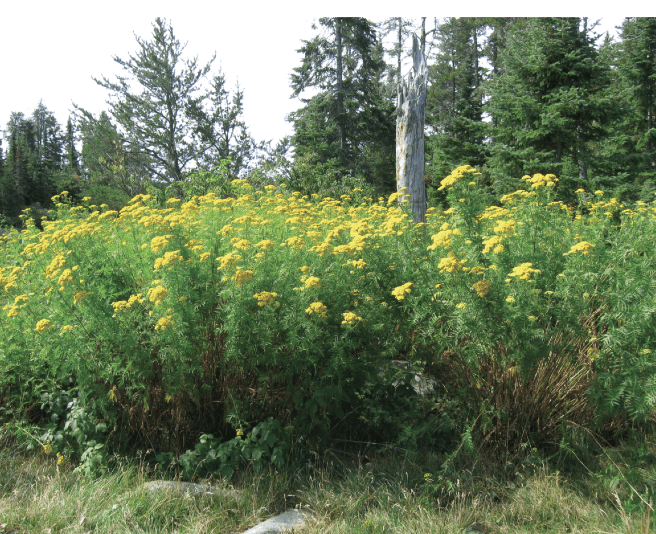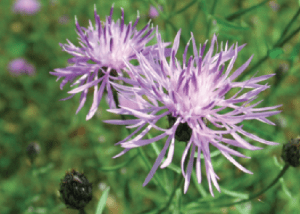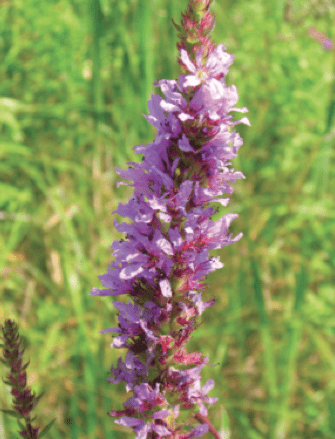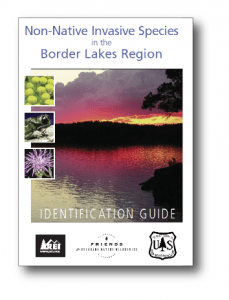
by Greg Seitz
The Superior National Forest is spearheading an effort to stop the spread of weeds into the Boundary Waters Canoe Area Wilderness.
For the past six years, Forest Service crews have been mapping out where invasive plants are growing in the Boundary Waters, and pulling them up by hand as much as possible. Those methods are not enough, according to the agency, and it’s now proposing to use herbicide to eradicate weeds in the wilderness.
Ecological invaders

There are 14 species of invasive plants known to be in the Boundary Waters. Three are top priority targets, each for their own reasons.
Purple loosestrife is the most invasive threat, while Canada thistle is more widespread. Jack Greenlee, Superior National Forest plant ecologist, says he has seen how quickly Common tansy spreads outside the BWCAW, and with the fact that it is only in four known places in the wilderness, he thinks it’s imperative to jump on it as quickly as possible.
Where diverse native plant communities now grow, these invasive plants could take over.
“It’s less tangible, but natural quality is definitely susceptible to impacts from invasives,” Greenlee says. Invasive plants could move the wilderness “…away from ecosystem processes that have always functioned there.”

A tipping point
“We’re in relatively good shape,” Greenlee says. A total of about 1,100 known weed sites add up to just 14 acres in the 1.1 million acre Boundary Waters wilderness.
However, left unchecked, these plants could fundamentally change the wilderness ecosystem, from its iconic rock outcrops to the plentiful wetlands.
Hand-pulling weeds requires at least annual visits to an infested site to eradicate non-native plants, and with a species like Canada thistle, which has a wide and shallow root system, it’s nearly impossible to permanently remove it from a site with just pulling.
This relatively small problem, and its potential to become much larger, is just why Greenlee says it’s time to act. “We need to catch this stuff now,” he says.
What to do
Greenlee and his colleagues believe a more aggressive approach is needed to minimize the impact of invasive plants in the Boundary Waters. The Forest Service’s proposal would use herbicides on the 14 acres of known invasive infestation, and allow for another 40-60 acres of treatment for sites that might emerge in the next decade.
A draft Environmental Impact Statement for the proposal was released for public comment earlier this year. Herbicides have previously been used in western wildernesses, including the Bob Marshall, Frank Church-River of No Return, and Selway-Bitterroot.
Restraint and caution are key parts of the plan, as the wilderness is intended to be as unmanaged by humans as possible.
“We’ve designed the project to use different application techniques depending on where we are,” Greenlee explains. “If we’re close to the water’s edge, we use a sponge to wipe herbicide onto the leaves of invasives so there is less risk of drift that might get herbicides into the water.”
Farther from the water, a backpack pump applicator could be used, with workers trained to ensure the spray lands on the plant they’re trying to reach.
The chemicals that would be used were selected based on their low toxicity to humans and wildlife, and the low application rates required. They would be transported in water-tight containers with rubber gaskets to prevent spills, or sinking. “If a canoe capsizes, the chemicals will be bobbing along in a waterproof barrel,” Greenlee says.

Unwitting accomplices
This human intervention is a response to human actions. Invasive plants can only get into the wilderness a few ways. It’s not a coincidence that most infestations are seen at campsites and portages.
“I think the biggest way new species are moving into the BWCAW is through recreational use,” Greenlee says. “Visitors come from all over, they may not be thinking about it. Maybe they are working in their garden or taking a walk in a park. They come with mud on boots and unknowingly transport Garlic mustard seeds.”
Weeds have also become common at entry points, and visitors might set their packs or gear down on them while they get ready to launch, and pick up seeds. While visitors bringing in seeds from home is hard to control, Greenlee says things like entry point infestations is something the Forest Service can control, and they have been actively trying to eliminate invasive species at the landings.
But while visitors have aided the spread of invasives, they can also help prevent further infestation. Educating and engaging wilderness users is a big part of the Forest Service’s plans, alongside pulling and herbicides. Learn more about how you can help in the sidebar.
Preservation preparation
The Forest Service proposal is nearing its final stages. The agency is working on responding to comments it received on the draft EIS and hopes to have a final decision by late summer, with implementation beginning soon after, or next spring at the latest.
While treatment will be focused at first on the 14 acres of known sites, the proposal’s inclusion of a plan to treat more infestations that might be found is key. Canada thistle seeds are spread by the wind, and infestations have already been found in areas burned by recent wild fires. The project will give the Forest Service the ability to respond rapidly to new sites like those.
All of this is meant to preserve the natural biodiversity of Minnesota’s boreal forest.
This article appeared in the Summer 2013 edition of Wilderness News >
Invasive species to look for
- Buckthorn
- Purple loosestrife
- Leafy spurge
- Garlic mustard
- Spotted knapweed
- Canada thistle
- St. John’s wort
- Common tansy
- Oxeye daisy
- Orange and yellow hawkweeds
- Plumeless thistle
- Eurasian water milfoil
- Tatarian, Morrow’s, and Bell’s honeysuckle
How you can help
-
Learn to identify invasive plants
-
Report infested sites to the Superior National Forest
-
Clean all your gear thoroughly before trips to the wilderness


